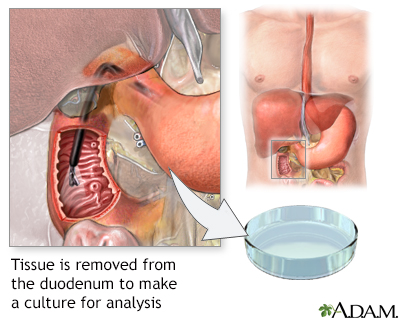Culture - duodenal tissue
Duodenal tissue culture
A duodenal tissue culture is a laboratory exam to check a piece of tissue from the first part of the small intestine (duodenum). The test is to look for organisms that cause infection.
Images

How the Test is Performed
A piece of tissue from the first part of the small intestine is taken during an upper endoscopy (esophagogastroduodenoscopy, also called an EGD).
The sample is then sent to a lab. There it is placed in a special dish (culture media) that allows bacteria or viruses to grow. The sample is looked at under a microscope regularly to see if any organisms are growing.
Organisms that grow on the culture are identified.
How to Prepare for the Test
This is a test done in a lab. The sample is collected during an EGD and biopsy procedure. Ask your health care provider how to prepare for this procedure.
Why the Test is Performed
A culture of duodenal tissue is done to check for bacteria or viruses that may lead to certain illnesses and conditions.
Normal Results
No harmful bacteria or viruses are found.
What Abnormal Results Mean
An abnormal finding means that harmful bacteria or a virus has been found in the tissue sample. Bacteria may include:
- Campylobacter
- Helicobacter pylori (H pylori)
- Salmonella
Risks
Risks of this test include:
- Bleeding
- Perforation of (poking a hole in) the gastrointestinal tract by the scope
- Infection
Some people may not be able to have this test because of other medical conditions.
Considerations
Other tests are very often done to look for infection-causing organisms in duodenal tissue. These tests include the urease test (for example, the CLO test) and histology (looking at the tissue under a microscope).
Routine culture for H pylori is not currently recommended.
References
Fritsche TR, Pritt BS. Medical parasitology. In: McPherson RA, Pincus MR, eds. Henry's Clinical Diagnosis and Management by Laboratory Methods. 24th ed. Philadelphia, PA: Elsevier; 2022:chap 63.
Lauwers GY, Mino-Kenudson M, Kradin RL. Infections of the gastrointestinal tract. In: Kradin RL, ed. Diagnostic Pathology of Infectious Disease. 2nd ed. Philadelphia, PA: Elsevier; 2018:chap 10.
McQuaid KR. Approach to the patient with gastrointestinal disease. In: Goldman L, Schafer AI, eds. Goldman-Cecil Medicine. 26th ed. Philadelphia, PA: Elsevier; 2020:chap 123.
Siddiqi HA, Rabinowitz S, Axiotis CA. Laboratory diagnosis of gastrointestinal and pancreatic disorders. In: McPherson RA, Pincus MR, eds. Henry's Clinical Diagnosis and Management by Laboratory Methods. 24th ed. Philadelphia, PA: Elsevier; 2022:chap 23.
BACK TO TOPReview Date: 5/6/2022
Reviewed By: Michael M. Phillips, MD, Emeritus Professor of Medicine, The George Washington University School of Medicine, Washington, DC. Also reviewed by David C. Dugdale, MD, Medical Director, Brenda Conaway, Editorial Director, and the A.D.A.M. Editorial team.

Health Content Provider
06/01/2025
|
A.D.A.M., Inc. is accredited by URAC, for Health Content Provider (www.urac.org). URAC's accreditation program is an independent audit to verify that A.D.A.M. follows rigorous standards of quality and accountability. A.D.A.M. is among the first to achieve this important distinction for online health information and services. Learn more about A.D.A.M.'s editorial policy, editorial process and privacy policy. A.D.A.M. is also a founding member of Hi-Ethics. This site complied with the HONcode standard for trustworthy health information from 1995 to 2022, after which HON (Health On the Net, a not-for-profit organization that promoted transparent and reliable health information online) was discontinued. |
The information provided herein should not be used during any medical emergency or for the diagnosis or treatment of any medical condition. A licensed medical professional should be consulted for diagnosis and treatment of any and all medical conditions. Links to other sites are provided for information only -- they do not constitute endorsements of those other sites. © 1997- 2024 A.D.A.M., a business unit of Ebix, Inc. Any duplication or distribution of the information contained herein is strictly prohibited.
